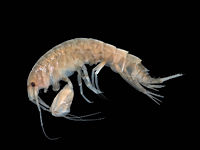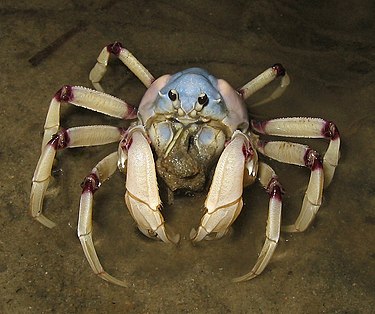Portal:Crustaceans
The Crustaceans Portal Crustaceans are a group of arthropods that are a part of the subphylum Crustacea (/krəˈsteɪʃə/), a large, diverse group of mainly aquatic arthropods including decapods (shrimps, prawns, crabs, lobsters and crayfish), seed shrimp, branchiopods, fish lice, krill, remipedes, isopods, barnacles, copepods, opossum shrimps, amphipods and mantis shrimp. The crustacean group can be treated as a subphylum under the clade Mandibulata. It is now well accepted that the hexapods (insects and entognathans) emerged deep in the Crustacean group, with the completed group referred to as Pancrustacea. The three classes Cephalocarida, Branchiopoda and Remipedia are more closely related to the hexapods than they are to any of the other crustaceans (oligostracans and multicrustaceans). The 67,000 described species range in size from Stygotantulus stocki at 0.1 mm (0.004 in), to the Japanese spider crab with a leg span of up to 3.8 m (12.5 ft) and a mass of 20 kg (44 lb). Like other arthropods, crustaceans have an exoskeleton, which they moult to grow. They are distinguished from other groups of arthropods, such as insects, myriapods and chelicerates, by the possession of biramous (two-parted) limbs, and by their larval forms, such as the nauplius stage of branchiopods and copepods. Most crustaceans are free-living aquatic animals, but some are terrestrial (e.g. woodlice, sandhoppers), some are parasitic (e.g. Rhizocephala, fish lice, tongue worms) and some are sessile (e.g. barnacles). The group has an extensive fossil record, reaching back to the Cambrian. More than 7.9 million tons of crustaceans per year are harvested by fishery or farming for human consumption, consisting mostly of shrimp and prawns. Krill and copepods are not as widely fished, but may be the animals with the greatest biomass on the planet, and form a vital part of the food chain. The scientific study of crustaceans is known as carcinology (alternatively, malacostracology, crustaceology or crustalogy), and a scientist who works in carcinology is a carcinologist. (Full article...) Selected article
Cancer pagurus, commonly known as the edible crab or brown crab, is a species of crab found in the North Sea, North Atlantic Ocean and perhaps in the Mediterranean Sea. It is a robust crab of a reddish-brown colour, having an oval carapace with a characteristic "pie crust" edge and black tips to the claws. A mature adult may have a carapace width of up to 25 cm (10 in) and weigh up to 3 kg (6.6 lb). C. pagurus is a nocturnal predator, targeting a range of molluscs and crustaceans. It is the subject of the largest crab fishery in Western Europe, centred around the coasts of the British Isles, with more than 60,000 tonnes caught annually.
Did you know?
Selected biographyThe Reverend Thomas Roscoe Rede Stebbing F.R.S., F.L.S. (February 6, 1835 – July 8, 1926) was a British zoologist, who described himself as "a serf to natural history, principally employed about Crustacea". Having trained as an evangelical Anglican, Stebbing expected to be a staunch opponent of Charles Darwin's recently published theory of evolution by natural selection. Following a critical review of The Descent of Man in The Times in 1871, Stebbing gained prominence by responding in Nature. Stebbing wrote a number of essays on the topic of Darwinism, in which he dissected the argument posited against it, and questioned various aspects of Christianity. His outspoken stance resulted in his being banned from preaching, and he was never offered a parish by the church. Most of Stebbing's scientific works, comprising more than 110 papers, covered amphipod crustaceans. Stebbing produced a monograph on the amphipods collected on the 1872–1876 expedition by HMS Challenger. He also produced a monograph of the Cumacea, a natural history of the Crustacea, and a biography of the Scottish naturalist and founder of the University Marine Biological Station, Millport, David Robertson. In 1906, Stebbing published the volume on Gammaridea for the series Das Tierreich. Selected image Soldier crabs of the genus Mictyris, including M. longicarpus (pictured) congregate at low tide to feed by filtering mud. As the tide rises, they bury themselves, digging in a corkscrew pattern. General imagesThe following are images from various crustacean-related articles on Wikipedia.
Crustacean lists
SubcategoriesRelated portalsWikiProjectsAssociated WikimediaThe following Wikimedia Foundation sister projects provide more on this subject:
Discover Wikipedia using portals
|





















































